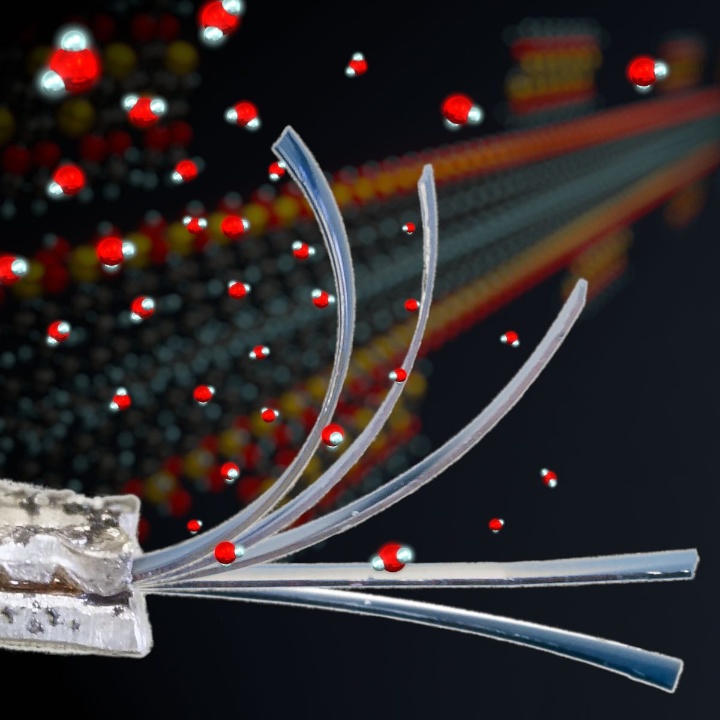Research groups led by the polymer chemist Prof. Sabine Ludwigs and the mechanic Prof. Holger Steeb at the University of Stuttgart have developed active double-layer structures from intelligent polymers based on the structures of a flowering plant, which lean of their own accord in response to humidity and then regain their original shape. They have also integrated the experimental results into a model which can be used to predict and control the characteristics of the curvature. This was reported in the renowned scientific journal Advanced Materials. The principle could for example be used for soft robotic arms or in biomedicine.
Ramonda myconi, the Pyrenean violet, impresses with its little purple flowers and its very particular leaves. They are made up of several layers, of which one can absorb water and swell up as a result while the others remain robust. In extremely dry weather, the store of water becomes depleted and the leaf starts to bend. When more humid weather returns, the leaf reverts to its original shape by itself.
This kind of behavior is also interesting from the perspective of materials science, namely regarding intelligent components which are said to exhibit continuously reversible behavior. This is the case in soft robotic arms for example, which perform movements thousands of times and are designed to cope with the change between dry and humid conditions without being damaged.
The model enables the curvature to be predicted reliably
In order to understand these materials, researchers at the Chair of Structure and Properties of Polymers (Prof. Sabine Ludwigs) and at the Institute of Applied Mechanics at the University of Stuttgart (Prof. Holger Steeb) used the example of the physical properties and the mechanical behavior of ramonda myconi leaves and recreated a simple double-layer structure made of polymers: a bending beam, in which changes in humidity trigger the curvature. Since it relates to an active (mechanical) component, it is referred to as an actuator. They then tested the bending beam in different climatic conditions, and described how the different parameters influenced the absorption of water, the stiffness, and ultimately the leaning properties. The researchers then integrated this data into a mathematical model which can be used to predict the mechanical behavior. “The combination of mechanical characterization and a simple analytical model enables a reliable prediction to be made of the curvature of the actuator. That is what is so special about our research”, explain Sabine Ludwigs and Holger Steeb.
In the future, both scientists want to expand their research to include multilayered structures as well as more complex geometries. In addition to humidity, they also want to investigate other triggers which can be used to induce the change, such as an electrical field.
A successful collaboration across faculties
The publication is the result of a very successful collaboration between scientists and engineers from different faculties. As part of the collaboration, the working groups led by Prof. Sabine Ludwigs and Prof. Holger Steeb contributed their complementary expertise in the fields of polymer chemistry, flexible electronics and their knowledge of the mechanics of functional polymer materials. The impetus behind the collaboration was provided by the transregional Collaborative Research Center TRR 141 (Biological Design and Integrative Structures – Analysis, Simulation and Implementation in Architecture), which has now come to an end. The results also benefit the Cluster of Excellence “Data Integrated Simulation Sciences” (SimTech) at the University of Stuttgart.
Expert Contact:
Prof. Sabine Ludwigs, University of Stuttgart, Chair of Structure and Properties of Polymers, tel. +49 711 685-64441, e-mail Sabine Ludwigs
Prof. Holger Steeb, University of Stuttgart, Institute of Applied Mechanics (Civil Engineering) and Cluster of Excellence EXC 2075 SimTech, tel. +49 711 685-66029, e-mail Holger Steeb
Original publication:
From Understanding Mechanical Behavior to Curvature Prediction of Humidity-Triggered Bilayer Actuators; authors: Carsten Dingler, Henry Müller, Matthias Wieland, Dominik Fauser, Holger Steeb, Sabine Ludwigs, online version: Advanced Materials January 2021, https://doi.org/10.1002/adma.202007982



